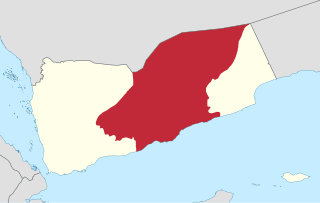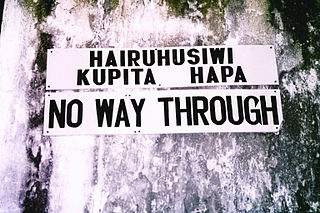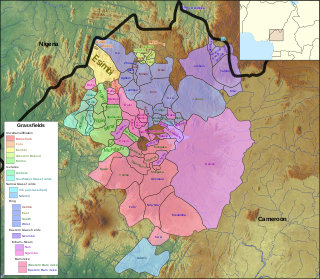Related Research Articles

The Bantu languages are a language family of about 600 languages that are spoken by the Bantu peoples of Central, Southern, Eastern and Southeast Africa. They form the largest branch of the Southern Bantoid languages.

Swahili, also known by its local name Kiswahili, is a Bantu language originally spoken by the Swahili people, who are found primarily in Tanzania, Kenya, and Mozambique. Estimates of the number of Swahili speakers, including both native and second-language speakers, vary widely. They generally range from 60 million to 150 million; with most of its native speakers residing in Tanzania.
Sheng is primarily a Swahili and English-based cant, perhaps a mixed language or creole, originating among the urban youth of Nairobi, Kenya, and influenced by many of the languages spoken there. While primarily a language of urban youths, it has spread across social classes and geographically to neighbouring Tanzania and Uganda.

Sandawe is a language spoken by about 60,000 Sandawe people in the Dodoma Region of Tanzania. Sandawe's use of click consonants, a rare feature shared with only two other languages of East Africa – Hadza and Dahalo, had been the basis of its classification as a member of the defunct Khoisan family of Southern Africa since Albert Drexel in the 1920s. Recent investigations however suggest that Sandawe may be related to the Khoe family regardless of the validity of Khoisan as a whole. A discussion of Sandawe's linguistic classification can be found in Sands (1998).

Hadza is a language isolate spoken along the shores of Lake Eyasi in Tanzania by around 1,000 Hadza people, who include in their number the last full-time hunter-gatherers in Africa. It is one of only three languages in East Africa with click consonants. Despite the small number of speakers, language use is vigorous, with most children learning it, but UNESCO categorizes the language as vulnerable.
The Gusii language is a Bantu language spoken in Kisii and Nyamira counties in Nyanza Kenya, whose headquarters is Kisii Town,. It is spoken natively by 2.2 million people, mostly among the Abagusii. Ekegusii has only two dialects: The Rogoro (upper-side) and Maate (lower-side) dialects. Phonologically, they differ in the articulation of /t/. Most of the variations existing between the two dialects are lexical. The two dialects can refer to the same object or thing using different terms. An example of this is the word for cat. While one dialect calls a cat ekemoni, the other calls it ekebusi . Another illustrating example can be found in the word for sandals. While the Rogoro word for sandals is chisiripasi , the Maate dialect word is chitaratara . Many more lexical differences manifest in the language. The Maate dialect is spoken in Tabaka and Bogirango. Most of the other regions use the Rogoro dialect, which is also the standard dialect of Ekegusii.
Dahalo is an endangered Cushitic language spoken by around 500–600 Dahalo people on the coast of Kenya, near the mouth of the Tana River. Dahalo is unusual among the world's languages in using all four airstream mechanisms found in human language: clicks, implosives, ejectives, and pulmonic consonants.
Kamba, or Kikamba, is a Bantu language spoken by millions of Kamba people, primarily in Kenya, as well as thousands of people in Uganda, Tanzania, and elsewhere. In Kenya, Kamba is generally spoken in four counties: Machakos, Kitui, Makueni, and Kwale. The Machakos dialect is considered the standard variety and has been used in translation. The other major dialect is Kitui.
The Kahe is an ethnic and linguistic group based southeast of Moshi in Kilimanjaro Region Tanzania. The Kahe language, or Kikahe, is in the Chagga cluster of Bantu languages. Three dialects are recognized: Kimwangaria, Msengoni and Kichangareni. Kikahe is spoken by 9,130 people, and is one of the smaller language communities in Tanzania.

Hadhrami Arabic, or Ḥaḍrami Arabic (ḤA), is a variety of Arabic spoken by the Hadharem (Ḥaḍārem) living in the region of Hadhramaut in southeastern Yemen, with a small number of speakers found in Kenya.
Burunge is an Afro-Asiatic language spoken in Tanzania in the Dodoma Region, by the Burunge people, a small community of about 28,000 native speakers that live in the Northeastern region of Tanzania. The Burunge belong to a cluster of Tanzanian groups known as Southern Cushites, which also categorizes Burunge as part of the South Cushitic language family. The Burunge live in close proximity to other languages such as the Rangi, Gogo and Sandawe, and ultimately, their language and culture is endangered by dwindling number of speakers and absorption by larger tribes.
The Northeast Coast Bantu languages are the Bantu languages spoken along the coast of Tanzania and Kenya, and including inland Tanzania as far as Dodoma. In Guthrie's geographic classification, they fall within Bantu zones G and E.
The Mwani language, also known by its native name Kimwani, is a Bantu language spoken on the coast of the Cabo Delgado Province of Mozambique, including the Quirimbas Islands. Although it shares high lexical similarity (60%) with Swahili, it is not intelligible with it. It is spoken by around 167,150 people. Speakers also use Portuguese, Swahili and Makhuwa language. Kiwibo, the dialect of the Island of Ibo is the prestige dialect. Kimwani is also called Mwani and Ibo. According to Anthony P. Grant Kimwani of northern Mozambique appears to be the result of imperfect shift towards Swahili several centuries ago by speakers of Makonde, and Arends et al. suggest it might turn out to be a Makonde–Swahili mixed language.
Pokomo (Kipfokomo) is a Bantu language spoken primarily along the East African coast near Tana River in the Tana River District by the Pokomo people of Kenya. Kipfokomo language originated from "Kingozi" the language, which Kiswahili was built from. "Kingozi" language is the precursor of Kiswahili. Pokomos are the only tribe in the world that speak "Kingozi" and sometimes are referred to as wangozi because they used to wear skins (Ngozi). All adult speakers of Pokomo are bilingual in Swahili, parts of East Africa's lingua franca.

Tanzania is a multilingual country. There are many languages spoken in the country, none of which is spoken natively by a majority or a large plurality of the population. Swahili and English, the latter being inherited from colonial rule, are widely spoken as lingua francas. They serve as working languages in the country, with Swahili being the official national language. There are more speakers of Swahili than English in Tanzania.

Babanki, or Kejom, is a Bantoid language that is spoken by the Babanki people of the Western Highlands of Cameroon.
Highland Chatino is an indigenous Mesoamerican language, one of the Chatino family of the Oto-Manguean languages. Dialects are rather diverse; neighboring dialects are about 80% mutually intelligible.
Zinza (Dzinda) is a Bantu language of Tanzania, spoken on the southern shore of Lake Victoria.
Ikizu is a Bantu language spoken by the Ikizu peoples of Tanzania. Its dialects are Ikizu proper and Sizaki. Maho (2009) treats Sizaki (Shashi) as a separate language. However, Ethnologue 16th edition retired the ISO code for Sizaki, merging it into Ikizu.

Mathias E. Mnyampala (1917–1969) was a Tanzanian writer, lawyer, and poet. Mnyampala was born on 18 Novembern 1917 according to a personal record form but he wrote in his autobiography, Maisha ni kugharimia, that he only knew the year with accuracy. He was born in the hamlet of Muntundya depending on the village of Ihumwa in Chamwino District in Dodoma region at the time part of German East Africa. He died on 8 June 1969 in Dodoma city, Tanzania. Mnyampala wrote in Swahili, the lingua franca of East Africa, not Cigogo, the native language of his ethnic group.
References
- ↑ Gogo at Ethnologue (18th ed., 2015) (subscription required)
- ↑ Jouni Filip Maho, 2009. New Updated Guthrie List Online
- Rugemalira, Josephat M. (2009). Cigogo, Kamusi ya Kigogo-Kiswahili-Kiingereza / Kiingereza-Kigogo, na Kiswahili-Kigogo / Gogo-Swahili-English, English-Gogo, and Swahili-Gogo Dictionary. ISBN 9987-691-25-0.
- Nurse, Derek and S. M. Mazengo. 1979. Gogo. African languages/Langues africaines 5. 70–76, 101–104.